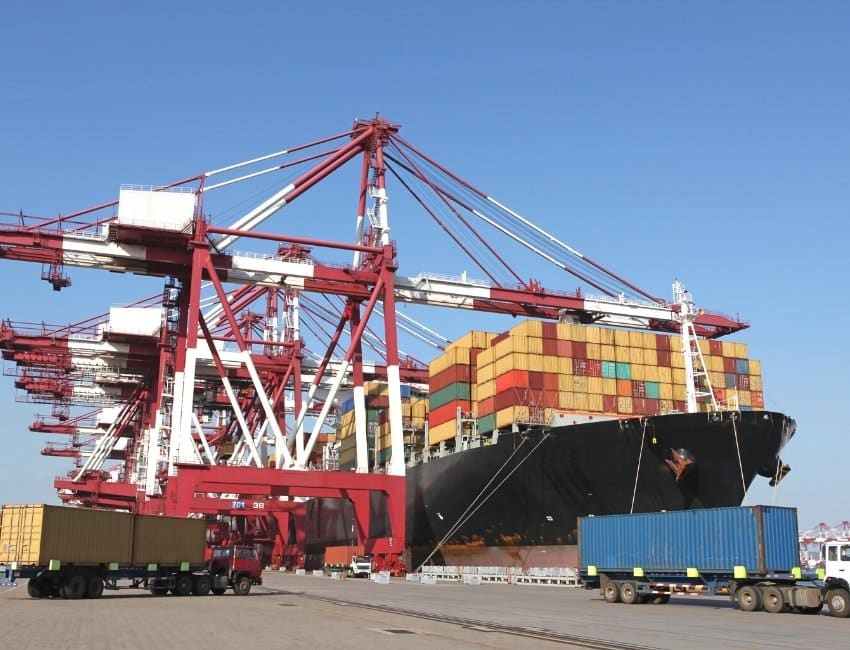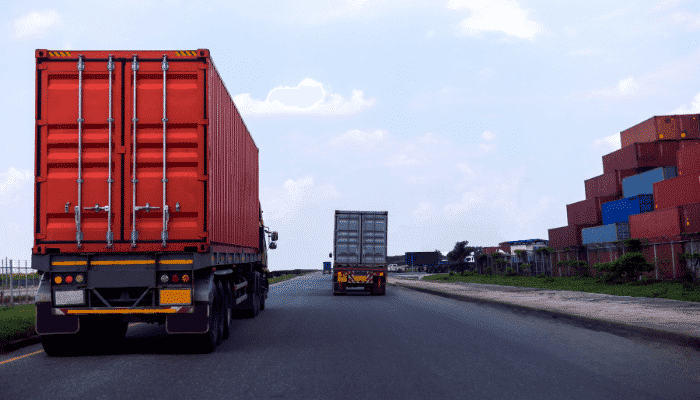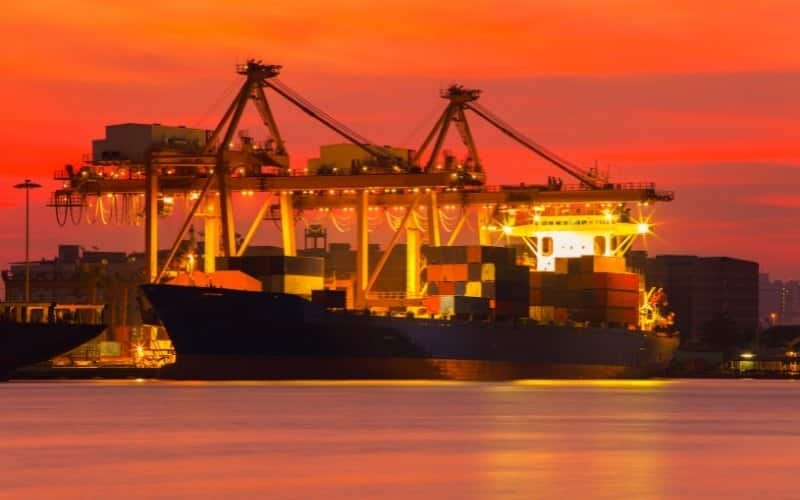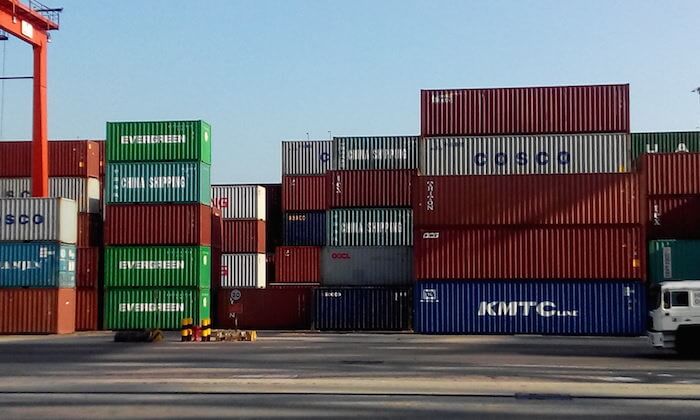What is Merchant Haulage?
Haulage is the transport of goods overland by truck or rail. A person or an organization that undertakes to transport goods overland is called a haulier or hauliers.
So, what is merchant haulage?
When a merchant or business decides to transport its goods overland and arranges contracted labourers and transport on its own, it is called merchant haulage. Merchant haulage can be best explained with the following example.
A car manufacturer in Turin, Italy has export orders for its spare parts to Kasserine, Tunisia. Kasserine is a land-locked governorate of Tunisia that is located about 300 kilometres to the west of Tunis.
The manufacturer arranges to transport the spare parts from its factory in Turin to the port of Genoa by road. The spare parts are then shipped to the port of Tunis from where the manufacturer has arranged to get it transported by road to Kasserine.

In this case, the leg of the journey from Turin to Genoa and Tunis to Kasserine is said to be by merchant haulage. In other words, the merchant has arranged and taken the responsibility of transport of the cargo overland. The shipping company’s responsibility for the cargo is only between the ports of Genoa and Tunis.
One main advantage of merchant haulage is that the shipper or merchant can appoint his preferred transport or cargo agent to move the goods from point A to point B overland. He does not utilize the service of the shipping company for this.
Transport of goods is a complicated and specialized activity that requires in-depth knowledge of the various factors that go into the successful movement of goods from one point to the other. Each of these factors is handled by experts and this is where merchant haulage comes in.
Haulage companies are experts in local transport and labour rules and regulations. Their services are usually far more superior than what is provided by shipping companies, whose expertise lies in the transport of goods by sea.
But having said this, it must be understood that shipping companies may also appoint hauliers to transport cargo on their behalf to the customer’s warehouse.
For this, the shipping company will charge over and above the haulage charges for their services. In merchant haulage, the merchant may get special or lower rates from the haulage company since he deals with them directly, especially if the services requested are regular.
In the case of merchant haulage, the clearing and transport are usually done by a local agent who is contracted by the merchant. Such agents will have a good knowledge of local government regulations, transport and labour rules.
In merchant haulage, the ocean leg and the inland legs (for export and import) of the cargo will be under separate bills of lading.
As opposed to merchant haulage, carrier haulage includes the movement of cargo from the shipper’s warehouse to the customer’s storage area by the ocean carrier using multiple modes of transport under a single bill of lading.
Intermodal Transport
When different modes of transport such as road, rail, sea, and air are used by a shipper to move goods from one point to another, it is known as intermodal transport. Merchant haulage falls under this category.
The merchant or shipper makes arrangements for the entire journey. It may be different companies handling the various legs of the transport.
Transport by the different modes is covered by different transport bills from each contractor that undertakes the different legs of the journey of the cargo.
Related Reading:
- What is an Intermodal Container?
- Watch: How Container Shipping Works: The Process Of Transporting Cargo In Containers
Multimodal Transport
There are end-to-end logistics providers who take care of the complete movement of goods and their port/customs clearance, from its storage at origin to the storage facility at the destination.
Carrier haulage falls under this category where the ocean carrier undertakes to move the cargo from its origin to the final destination.
The carrier’s appointed agents will take care of all modes of transport that are involved to move the cargo whether by road, rail, sea, or air. This is known as multimodal transportation.
The main feature here is that a single bill of lading issued by the main carrier covers the entire journey of the cargo from origin to destination by the different modes of transport.
The different modes and the corresponding legs of the journey are shown on the bill of lading. In multimodal transport the main carrier takes responsibility for the cargo and any subsequent claims as a result of accidents and damages during the entire transport will fall on them.
A general observation here is that shipments of high value are normally shipped by air and the shortest possible route to avoid the handling at several ports and other transit points that the usual intermodal or multimodal transport will require.
Merchant Haulage Vs. Carrier Haulage
An organization must have a dedicated department to handle merchant haulage. It is easier to control and manage the different aspects of transport since the organization will be handling its cargo through contracted agents. It can also select the right transit schedule for its cargo.
There could be situations where the organization is better equipped to negotiate with transport providers and clearing agents to get better service, rates, and terms. Another scenario is where the goods are of high value or need special handling. In such cases, the merchant would prefer to handle the inland haulage part.
However, since the merchant will be dealing with different companies, administration and paperwork could prove to be complex. Keeping track of the various contracts, their contacts, and ensuring seamless operations between the different companies need a dedicated and professional team.
Clearing and storage have to be planned effectively and accurately as any delay in clearance can result in demurrage, detention, or storage charges. Inordinate delay in the clearance of cargo by the merchant’s agent can even result in the goods being shipped back to their origin at the merchant’s cost!

On the whole, merchant haulage could turn out to be more expensive to the business than letting a shipping carrier handle the end-to-end transport operations.
In carrier haulage, the merchant does not have to worry about transport, clearance, and other factors thereby making it easier to focus on their core business interests.
The main carrier will be responsible for the goods from their origin to the destination. Loading, unloading, and coordination of all other related activities are managed by the carrier and its agents. It might also work out cheaper due to economies of scale enjoyed by the shipping carrier.
Delays are usually handled efficiently by the carrier by making immediate alternate arrangements through their contacts at the various ports and other agencies.
Most shipping companies have effective Transport Management Systems (TMS) that allow their customers to view the real-time position of their cargo. TMS are platforms that help shipping companies and their customers to plan and optimize the movement of goods.
Demurrage, Detention, and Storage Charges
Let us take a brief look at demurrage, detention, and storage charges and how it works. These are charges from the carrier and the port that prompt the consignee (customer) to act fast on his cargo. Delay from the customer’s side means additional costs to the carrier as well as the port and hence the container turnaround time matters.
Shipping lines allow a certain number of free days to the consignee for clearance and removal of cargo from the port. The cargo that is discharged from the ship is unpacked from the allotted terminal area or taken directly to the customer’s storage (as in the case of container loads).
When the consignee does not clear his cargo within the specified number of days, the shipping line will charge them demurrage. Demurrage ends when the consignment is taken outside the terminal for delivery.
Demurrage is charged by container, by day. It varies between carriers, ports, and the type of equipment used, for example; reefers and dry containers.
What are detention charges?
When a container load is taken for delivery to the customer’s warehouse, the empty container has to be returned after destuffing, to the port, or the empty container depot within the prescribed time.
The shipping line will levy a charge for the days exceeded by the customer and that is known as detention charges. Like demurrage, detention charges are also charged by container, by day, depending on the equipment type.

Storage charges are levied by the port for storage space used inside the port terminal or container yard. It is calculated from the time the goods are delivered at the port storage area and ends when these goods are removed from there.
Avoiding demurrage, detention, and storage charges are important in merchant haulage as the merchant is solely responsible for clearance and taking custody of the cargo. If clearance is not planned properly, it can result in these charges. There might be situations where demurrage and detention charges are unavoidable such as unexpected delays in unloading from the ship, etc.
Some shipping lines levy a charge on shipments that are released to merchants. These charges cover the costs to the shipping line for the administrative processes involved in the release of the cargo. This may require the submission of an endorsed on-line release form in the shipping company’s portal or the same by hardcopy. The original bill of lading will have to be submitted and all outstanding dues to the shipping company settled.
Return or Restitution of Empty Containers
Containers that are used for the transport of cargo should be returned to the ocean carrier’s depot or the port as prescribed by the carrier, once goods have been unloaded and delivered to the customer at destination. This is commonly referred to as restitution.
In merchant haulage, it is the merchant’s duty to check with the carrier on the points of restitution for the return of the empty containers or empties. Normally empties are returned to the carrier at the port of exit of the cargo. However, it could also be to the port from where the container was picked up by the merchant.

Just like the logistics involved in shipping loaded containers and consignments, handling of empty containers also requires careful planning and execution. In the event of port congestions, ports may place a temporary ban on empties restitutions to the port.
Port congestions are caused due to labour problems or in some cases simply due to piling up of empty containers. The latter happens when several ocean carriers skip one or two ports of call from a string resulting in empties not being picked up.
What is a string? Cargo vessels usually have a fixed route and ports of call. This is known as the Schedule. The ports of call, collectively, in a vessel’s schedule are known as the string.
How can Demurrage, Detention, and Storage Charges be Reduced or Avoided?
While these charges may be unavoidable at times, it can be reduced or even completely avoided with proper planning and care.
A few suggestions that can help to reduce or avoid the charges are as follows:
- Be aware of the current demurrage, detention, and storage charges. These can be obtained from the carrier and the port.
- Customs clearance may sometimes take time. Consider delays while planning clearance of cargo and all other related activities.
- Arrangements to destuff cargo and store them in the right space have to be made in advance to avoid delays and the subsequent detention charges.
- Maintain an effective communication network with the ocean carrier or its agent, port contacts, and freight forwarder or clearing agent.
These steps can help especially in merchant haulage where the merchant has to plan and make arrangements for clearance and unloading.
Demurrage, detention, and storages charges vary widely between different ports and shipping lines.
The business model of merchant haulage can be useful to business houses that have regular loads of shipments coming in from a few fixed locations at regular intervals. These are usually customs cleared and delivered to fixed locations at the destination.
In such cases, the merchant can enter into special agreements with separate service providers such as carriers, inland clearance agencies, transport agents, labour agencies, etc.
Exclusive business agreements usually involve special rates and other terms of payment that are beneficial to the merchant. However, all the pros and cons have to be studied carefully before any such decision is taken to avoid pitfalls.
You might also like to read:
- Telex Release; Everything You Wanted to Know
- What Is CBM Rate In Shipping?
- What is Seaway Bill in Shipping?
- What is Non-Vessel Operating Common Carrier (NVOCC)?
- Voyage Charter vs Time Charter
- What is a Logistics Cycle?
Disclaimer: The authors’ views expressed in this article do not necessarily reflect the views of Marine Insight. Data and charts, if used, in the article have been sourced from available information and have not been authenticated by any statutory authority. The author and Marine Insight do not claim it to be accurate nor accept any responsibility for the same. The views constitute only the opinions and do not constitute any guidelines or recommendation on any course of action to be followed by the reader.
The article or images cannot be reproduced, copied, shared or used in any form without the permission of the author and Marine Insight.
Do you have info to share with us ? Suggest a correction

About Author
Hari Menon is a Freelance writer with close to 20 years of professional experience in Logistics, Warehousing, Supply chain, and Contracts administration. An avid fitness freak, and bibliophile, he loves travelling too.
Latest Maritime law Articles You Would Like:
Latest News
- What is the Purpose of DG Shipping?
- What are Logistics Risks?
- How Port and Terminal Operators Can Control Emissions?
- Minimum Quantity Commitment (MQC) and Liquidated Damages in Container Shipping: Concept and Relevance
- MARPOL (The International Convention for Prevention of Marine Pollution For Ships): The Ultimate Guide
- The Ultimate Shipping Container Dimensions Guide
Subscribe To Our Newsletters
By subscribing, you agree to our Privacy Policy and may receive occasional deal communications; you can unsubscribe anytime.















